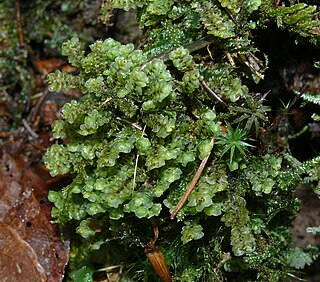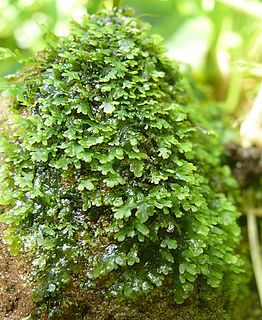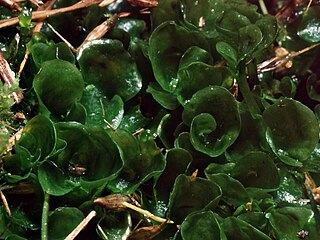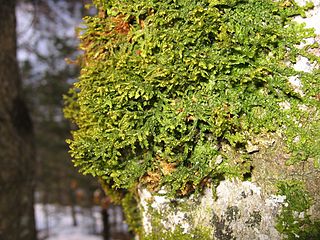Related Research Articles

Marchantiales is an order of thallose liverworts that includes species like Marchantia polymorpha, a widespread plant often found beside rivers, and Lunularia cruciata, a common and often troublesome weed in moist, temperate gardens and greenhouses.

Lepidoziaceae is a family of leafy liverworts. It is a group of small plants that are widely distributed.
Andrewsianthus is a genus of liverworts in the family Lophoziaceae.

Bazzania is a genus of liverwort in the family Lepidoziaceae.

Frullania is the only genus of liverworts in family Frullaniaceae. It contains the following species:
Kurzia is a genus of liverworts in the family Lepidoziaceae. It contains the following species. Kurzia crenacanthoideaG. Martens is a synonym of Kurzia gonyotricha(Sande Lac.) Grolle.

Scapania is a genus of liverworts in the family Scapaniaceae. It contains the following species :

Carl Moritz Gottsche was a German physician and bryologist born in Altona. He was the father of geologist Carl Christian Gottsche (1859-1909).
Johann Bernhard Wilhelm Lindenberg was a German bryologist who worked as a lawyer in Bergedorf.

Pleurozia is the only genus of liverworts in the family Pleuroziaceae, which is now classified in its own order Pleuroziales, but was previously included in a broader circumscription of the Jungermanniales. The genus includes twelve species, and as a whole is both physically distinctive and widely distributed.
Jensenia spinosa is a dioicous bryophyte plant in the liverwort family Pallaviciniaceae. It is the only African member of the genus Jensenia, and generally occurs at high elevations. It is widespread but scarce, and has been found in South Africa, Malawi, Tanzania, Rwanda, the Democratic Republic of the Congo, as well as the islands of Mauritius, Réunion and Saint Helena.

Riccardia is a plant genus in the liverwort family Aneuraceae.

Haplomitrium is a genus of liverwort.

The Flora of Lord Auckland and Campbell's Islands is a description of the plants discovered in those islands during the Ross expedition written by Joseph Dalton Hooker and published by Reeve Brothers in London between 1843 and 1845. Hooker sailed on HMS Erebus as assistant surgeon. It was the first in a series of four Floras in the Flora Antarctica, the others being the Flora of Fuegia, the Falklands, Kerguellen's land, etc (1845–1847), the Flora Novae-Zelandiae (1851–53), and the Flora Tasmaniae (1853–59). They were "splendidly" illustrated by Walter Hood Fitch.

Pallaviciniales is an order of liverworts.

Porellales is an order of liverworts.
Gottschelia is a genus of liverworts belonging to the family Cephaloziellaceae.
Anastrophyllum is a genus of liverworts belonging to the family Anastrophyllaceae.
Goebeliellaceae is a family of liverworts belonging to the order Porellales. The family consists of only one genus: GoebeliellaSteph..
References
- 1 2 3 "Gottschea Nees ex Mont". www.gbif.org. Retrieved 14 May 2021.
- ↑ Burkhardt, Lotte (2022). Eine Enzyklopädie zu eponymischen Pflanzennamen [Encyclopedia of eponymic plant names](pdf) (in German). Berlin: Botanic Garden and Botanical Museum, Freie Universität Berlin. doi:10.3372/epolist2022. ISBN 978-3-946292-41-8 . Retrieved January 27, 2022.